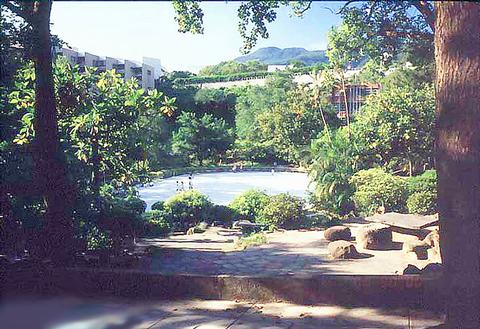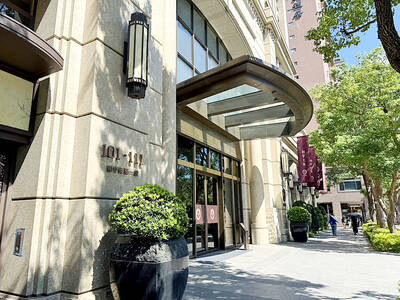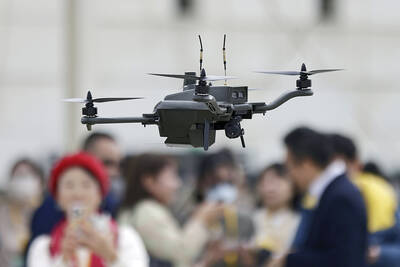With Taipei poised to build the city's first cable car system in Peitou District, cultural workers and local opposition leaders are going head-to-head with the city to voice their strong opposition to the plan.
While the city insists that the line is designed to ease traffic problems in Yangmingshan National Park and to boost the waning economy of Peitou District, opponents argue that it will do just the opposite.
"As a local resident, I don't appreciate the prospect of having our skyline marred by a cable car line combined with a mass of tourists coming here during the flower season," said Huang Kuei-kuan (

PHOTO: COURTESY OF LIVING ENVIRONMENT MAGAZINE
Huang and other opponents of the cable car system began their battle on July 18 when Taipei City Mayor Ma Ying-jeou (馬英九) officially expressed his intention to go ahead with the project and construct it using the BOT (built-operate-transfer) model -- meaning the city will team up with private contractors who will build the project, while the city provides the land, which it acquired for only NT$150 million. This is seen as the fastest and most cost-effective way to complete the project.
In an attempt to persuade the city to drop the project, opponents have launched an unofficial signature drive -- which has so far amassed over 3,000 individual signatures from local communities.
They also have sent out e-mails and used the media to make their voices heard.
In a bid to quell the antagonism, the city on July 31 gave an official presentation to outline the benefits of the project. A second presentation will be held tomorrow.
The project is one of the promises made by Mayor Ma during his election campaign and it seems that the city may eventually go ahead with it, one way or another.
The proposed line is 4.9km long, would cover 1.6 hectares over four boroughs, and is set to have four stops, with the starting point being at the skating rink located at the Chinshui Park (親水公園) in Hsin Peitou, continuing on to Lungfeng Valley (龍鳳谷) on Yangmingshan, the first parking lot in Yangmingshan National Park, and finishing off at the second parking lot.
The city hopes to complete the one-year, NT$1 billion project by the end of 2003.
The history of the project is a long one. It dates back to 1979 when then-Taipei mayor Lee Teng-hui (李登輝) abrogated prostitution in Peitou. Although the move eliminated over half of the notorious hot springs hotels where prostitution was conducted, it also endangered the area's economy.
The original plan
In a bid to boost the region's economy as well as to ease the traffic problem, Yangmingshan National Park Headquarters (YNPH, 陽明山國家公園) in 1989 commissioned a US-based research center, RHAA, to come up with possible solutions to these problems. One of the two alternatives the center proposed was to build a network of cable cars connecting the park with Peitou, Tienmu, Tamsui, and Niuputzu (牛埔子).
The YNPH in 1991 entrusted a Taiwan-based research company, Central Engineering Consultant and Research Inc (
Three possible routes were proposed: the first option would begin at Peitou Hot Spring Public Bath Pool (
The National Park Planning Committee, operating under the Ministry of the Interior later handed back the proposal to the park headquarters and requested the project be integrated with the mass rapid transit (MRT) system.
In response, then-mayor of Taipei Chen Shui-bian (
In 1998, the city's Bureau of Public Works (
Strong opposition
Although the city government claims that the cable car will ease traffic problems on Yangmingshan and help the economy of Peitou, cultural and historical workers hold a different view.
"How do you expect the traffic problem to be solved with one cable car line?" Huang said. "It's a bad idea because not only does it not solve Yangmingshan's traffic problem, it may transfer the problem to Peitou."
Neither does the cable car spur opportunities for the area's businesses, Huang said.
"What it really does is swiftly transfer people out of Peitou to Yangmingshan, instead of bringing them here to spend their money," she said, adding that the route also concerned her.
"It's not a good choice to start [the line] at the 87-year-old Chinshui Park, because it's so rich in history and is a favorite local gathering place ? The construction of the cable car line would sabotage the entire historical and ecological aspect of the park," she said.
As well, the squeaking noise of the cable lines may have a negative impact on teaching quality at Hsinmin Junior High School, which is below part of the route, she said.
Ecology and safety problems are another two of her concerns.
"The 26 colossal supporting pillars and the safety net below the line will not only be ugly, but won't blend in with the forest around it," she said. "The sulfurous fumes from the hot spring may also pose a threat to the machinery."
Instead, Huang said, cultural conservation is the ultimate way to attract tourists to Peitou and boost the area's economy.
"Haven't we seen more tourists coming here since the Peitou Hot Spring Museum was made accessible to the public?" she said, pointing out that the district has a total of 11 historic sites.
The museum was declared a national historic site in 1997 and was opened to the public the following year.
Chen Lin-sung (
"Do we really need the cable car? Will it really benefit local residents?" he asked. Chen also questioned the proposed fare, which he said is too high.
"Do you think people will spend a couple of hundred dollars just to visit four spots in Yangmingshan National Park, when the park actually has over 30 attractions?" he said.
Prices for a one-way ticket are slated at NT$100 per person during the flower season and NT$50 during off-season. In other words, a person will spend between NT$100 and NT$200 for a round trip, and the cost for a family of four would be between NT$400 and NT$800.
Chang Lu-wen (
He said his reasons are simple: half of the route would cover his borough -- which houses half of the district's hot spring hotels and eight of the district's 11 historic sites.
"We don't need to boost the economy here because it's already a prosperous place," he said. "What's wrong with keeping it the way it is, as a residential area?"
Robust rebuttal from the city
Although the city has shown sincerity in tackling the concerns of opponents of the project, said Hsu Cheng-ping (許正平), planning chief of the city's Bureau of Public Works, he said he is fed up with the constant whining from protagonists.
"They're rejecting something just because they have an opportunity to do so," he said. "They're so conservative that they think no development is the best development."
The opposing forces are not as strong as they seem, he said.
"I would like to make one thing clear here: most people have the impression that the majority of people are opposed to the idea, but it's not true. The reason is that those who approve of the idea don't feel the need to have their voices heard," he said.
To prove it, Hsu said 39 out of the district's 40 borough wardens approve of the project. In addition, three surveys administered by the bureau have shown that about 60 to 80 percent of local residents favor the project.
"We've been very flexible in terms of making adjustments to the plan," he said, adding that they have reduced the number of houses which would need to be demolished from 60 to 30, and moved the starting point, originally set at Chinshui Park, to the skating rink which is 100m west of the park.
As for the expensive fares, Hsu said, [the current prices] are just for the sake of reference.
"Everything is negotiable," he said. "We're just setting the ceiling for future contractors."
Hsu explained why the project does not require an environmental impact assessment, something that cultural workers have fiercely criticized.
"The Environmental Impact Assessment Law stipulates that no assessment is needed if the development area of a project is less than 4 hectares and the amount of soil dug up is less than 10,000m2," he said.
The project covers an area of 2.4 hectares and the amount of soil that would be have to be dug up is estimated at 5,000m2.
Hsu said that he personally does not care whether or not the cable car system is built.
"As a civil servant, I do what my superior tells me to do. It doesn't really matter to me whether the project is eventually realized. I won't get paid less for that, but the way that opponents are making waves really upsets me," he said.

FORCED LABOR: A US court listed three Taiwanese and nine firms based in Taiwan in its indictment, with eight of the companies registered at the same address Nine companies registered in Taiwan, as well as three Taiwanese, on Tuesday were named by the US Department of the Treasury’s Office of Foreign Assets Control (OFAC) as Specially Designated Nationals (SDNs) as a result of a US federal court indictment. The indictment unsealed at the federal court in Brooklyn, New York, said that Chen Zhi (陳志), a dual Cambodian-British national, is being indicted for fraud conspiracy, money laundering and overseeing Prince Holding Group’s forced-labor scam camps in Cambodia. At its peak, the company allegedly made US$30 million per day, court documents showed. The US government has seized Chen’s noncustodial wallet, which contains

SUPPLY CHAIN: Taiwan’s advantages in the drone industry include rapid production capacity that is independent of Chinese-made parts, the economic ministry said The Executive Yuan yesterday approved plans to invest NT$44.2 billion (US$1.44 billion) into domestic production of uncrewed aerial vehicles over the next six years, bringing Taiwan’s output value to more than NT$40 billion by 2030 and making the nation Asia’s democratic hub for the drone supply chain. The proposed budget has NT$33.8 billion in new allocations and NT$10.43 billion in existing funds, the Ministry of Economic Affairs said. Under the new development program, the public sector would purchase nearly 100,000 drones, of which 50,898 would be for civil and government use, while 48,750 would be for national defense, it said. The Ministry of

SENATE RECOMMENDATION: The National Defense Authorization Act encourages the US secretary of defense to invite Taiwan’s navy to participate in the exercises in Hawaii The US Senate on Thursday last week passed the National Defense Authorization Act (NDAA) for Fiscal Year 2026, which strongly encourages the US secretary of defense to invite Taiwan’s naval forces to participate in the Rim of the Pacific (RIMPAC) exercise, as well as allocating military aid of US$1 billion for Taiwan. The bill, which authorizes appropriations for the military activities of the US Department of Defense, military construction and other purposes, passed with 77 votes in support and 20 against. While the NDAA authorizes about US$925 billion of defense spending, the Central News Agency yesterday reported that an aide of US

NINE-IN-ONE ELECTIONS: Prosecutors’ offices recorded 115 cases of alleged foreign interference in the presidential election campaign from August 2023 to Dec. 13 last year The National Security Bureau (NSB) yesterday said that it has begun planning early to counter Chinese interference in next year’s nine-in-one elections as its intelligence shows that Beijing might intensify its tactics, while warning of continued efforts to infiltrate the government and military. The bureau submitted a report to the Legislative Yuan ahead of a meeting today of the Foreign Affairs and National Defense Committee. “We will research situations in different localities and keep track of abnormalities to ensure that next year’s elections proceed without disruption,” the bureau said. Although the project is generally launched during election years, reports of alleged Chinese interference